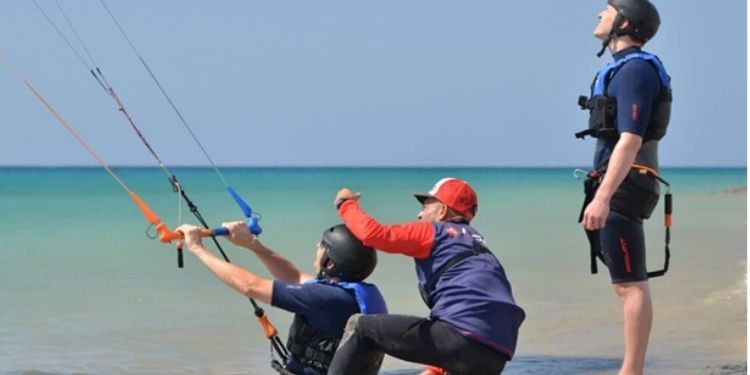Kite Surfing, Get Started!

Kitesurfing is one of the most exciting water sports. But how can you start? How long does it take to learn? To find out all about becoming a bona fide kitesurfer, Just read below!
These tips will help you get there quickly.
Table of Contents
ToggleWhat is kitesurfing?
Kitesurfing uses wind to propel you through the water. Kitesurfing doesn’t necessarily have to be about surfing waves. It can be done in mirror-flat lagoons as well as on big waves or in choppy waters. You only need wind and water.
Kitesurfing is a great sport that offers a lot of progression and fun. Once you have mastered the basics of kitesurfing, such as riding upwind and keeping it steady, you can go faster, jump, do freestyle tricks, ride waves, or take long ‘downwinders’ along the coast.
What skills are required to get started?
Many beginners are new to watersports, kite-flying, and boardsports. Many have never flown a boat or taken up a watersport. Some people have never donned a wetsuit. You should feel safe swimming in open water for safety reasons.
How fit should you be?
Kitesurfing doesn’t require you to be super fit. Kitesurfing is easy with lightweight kites. A general fitness level will make you move faster, be more agile on the water, and prevent injuries.
Do you require lessons?
Yes. Anyone who is serious about kitesurfing will agree that beginners lessons are crucial. A good instructor will not only get you riding quickly but also provide you with safety information and procedures. You are a danger to your safety and that of others on the beach and water.
Where can you take lessons?
Kitesurf schools and instructors are available all over the world. Many allow you to book online and offer a variety of lessons, including weekend and weekday lessons as well as longer packages.
What equipment do you need to teach lessons?
Kite schools and instructors should be able to provide it. You will find a variety of boards, kites, and safety equipment that can be used to suit your needs and in a wide range of wind conditions.
You may be required to have your own wetsuit in certain cases. Check with the school before you make this decision. You should also protect yourself from the sun, especially when you are studying abroad. Consider a waterproof sun-cream, a thin top to protect your arms, and a cap.
What can I expect to learn?
The three main elements of a standard beginner’s course are:
- Flying a kite from land: landing, launching, and control
- Flying a kite on the water: Control, body drag, and relaunching
- Get up and ride on a board
These elements will teach you about:
- Safe kiting conditions in an area
- Understanding wind direction, strength, and gusts
- Learn how tides, currents, and hazards affect you
- The right equipment for your conditions
- Set-up, tuning, and packing down your equipment
- What to do in an emergency? Safety procedures
- Board-starts (getting on the board)
- Speed control and continuous riding
- How to stay upwind
- Rules and rights of passage on the water
What are the biggest challenges for beginners?
For many, building confidence and trusting your equipment are the first hurdles. Although it can be scary to strap yourself to a kite, a skilled instructor will make you feel comfortable and help you understand how safe modern kiting equipment is. It can take some time to build up confidence and get started.
What kit should a beginner buy?
You don’t have to purchase anything right away. Any good instructor will provide the equipment. Kites are available for many levels. Most kites have an inflatable leading edge and a bridle that you can attach your lines to. You don’t have to worry about special designs at a beginner level. Modern “everyday” kites are available in either standard ‘bow or ‘delta shapes, which is great for beginners. C-kites, which have lots of power and lift; hybrids (a cross-section between a C/kite and bow-kite); foil kites are used for hydrofoil kitesurfing.
Do you think it is okay to purchase second-hand gear?
While an older board may be fine, a newer model is better for lines, bars, and kites. New equipment is constantly evolving, especially for kites. Every year, equipment gets better. Buy the best equipment possible and purchase it from a trusted shop.
Is it necessary to have a permit in order to kitesurf on your own?
You don’t usually need a license, but third-party liability insurance is highly recommended in the event you injure or crash into another person’s boat, car, or expensive kitesurfing kite. You should check before you launch somewhere new.
This post was written by Aaron McClearnon, Owner of Elite Watersports. At Elite Watersports, We strive to provide exceptional service and genuine interactions with those interested in kiteboarding lessons. We hold dear our passion for being out on the water and maintain this as our foundation for all business practices.
Mike Farrier possesses over 18 years of hands-on experience in software and web development, SEO, social media marketing, eCommerce, and digital marketing. He has been active in the online domain since 2019, serving as a seasoned SEO and digital marketing consultant.
Recommended For You
Spread the loveAre you ready to turn reading into a rewarding experience? With ReddyBook Club, the journey from sign-up to
Spread the loveIntroduction Voice AI technology has revolutionized the way we interact with digital platforms. Among the many available voices,
Spread the lovePublic chats are an essential tool for digital communication, enabling people to connect, share ideas, and build communities




